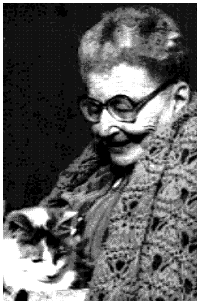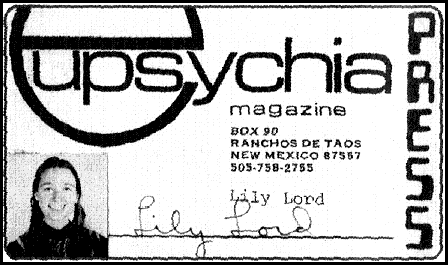My Life in a
Group Marriage
Commune
Margaret Hollenbach
(University of New Mexico Press)
Angry God:
Recollections of My Life with
John Peabody Harrington
Carobeth Laird
(University of New Mexico Press)

Yet each book offers the prosaic and the hallucinatory, the latter when reporting the interior lives about which anthropologists (who must be outside their subjects) can only speculate. It is like watching a silent movie without music: the cues and builds that coach our emotions are gone, leaving only what we see and our lonely reaction to it. With these writers you have to listen to yourself since they avoid telling you how to feel. Yet both books are full of drama and power as their stories unfold.

They married and thus began Laird's long process of falling out of love with Harrington, narrated against the backdrop of ethnological work in the early 20th century. Harrington's work always came first, and work he did. He left over 750,000 pages of field notes: his notes on the Chumash Indians alone filled 60 boxes. He was also miserly, paranoid, self-absorbed, anti-Semitic, critical and insensitive. Laird, his assistant, spent years among the Indians and published scholarly articles as well.
Margaret Hollenbach was a twenty-five-year-old anthropology grad school dropout when she joined The Family in Taos, New Mexico in the spring of 1970. A college graduate at nineteen, she was
- stumbling around in the void of meaning that my family, community, education and century created for me, and besides that, I thought I was screwed up, a magically self-fulfilling belief.
Lonely and rootless when she met a couple of Family members she quickly decided to join them and moved to Taos. She worked in Family enterprises, slept with Family members, including the charismatic leader, Byron, and participated in the Family's ad-hoc Gestalt therapy sessions.
Part of both of these books is the story of a cult: how one enters; how one survives; how one leaves; and finally, the price one pays. How do we set ourselves up to join a cult? Laird is caught up in romantic notions about a handsome and learned older man and willingly becomes the sole member of the John Peabody Harrington cult. Hollenbach, older, perhaps wiser and certainly more intellectually critical, is seduced into the cult by her own longing for connection and the pleasures of Gestalt therapy.
Hollenbach's life in The Family lasted a few months, while Laird remained with John for seven years. Laird's life was sometimes hazardous:
- I would not believe that any man could bring himself to leave a wife (whom he said he loved) alone [in a remote part of the San Bernardino mountains] in the eighth month of pregnancy, without food, money or transportation --- not yet accepting the fact that this man was cast in a different mold and could easily do such a thing, with no sense of dereliction and without intentional cruelty.
When he returned there would be months of twelve-hour days working on the field notes. Their life was not without pleasures for Laird, but they were simple and few.
 Finally, Laird met George Laird, a Chumash Indian, and her world changed. "George stood behind the forge and I first saw his face glowing in coppery light."
Finally, Laird met George Laird, a Chumash Indian, and her world changed. "George stood behind the forge and I first saw his face glowing in coppery light."
- That was the way I was to see it and remember it through all the years, in actuality, in daydreams, and in night dreams, lit by the coals in forge or campfire, by the light of kerosene lantern or lamp ... always the same beautiful contours, the same deep lines cut by sun and laughter in his dark brown skin, the same inimitable expression of kindness, intelligence, strength and laughter lurking just below the surface.
It was love at first sight for both, and their love affair is a fine and romantic story, simply and sincerely told.
Hollenbach's Family life hazards were more spiritual than physical, but her life had drama as well. Restless, seeking love and independence, intellectual and romantic, Hollenbach had already moved around much of the western U.S. by the time she met up with the Family. She was deeply involved with a pioneering community radio station, KRAB in Seattle. And in the space of a few weeks she lost her lover, her job and almost her life when she fought off the attack of a serial killer. Her therapist advised her --- a week before his own untimely death --- "You know Margaret, I never say this to my patients, but you are in such a crazy situation."
- Your work, your friends, this homicidal maniac, you are in a setting that could ruin a person! I never say this, but my advice to you is --- leave town! Go someplace normal and get a new start.
Hollenbach is more introspective and sharing about her passions than Laird, but her cool intellectual persona makes her less explicable to me than the passionate Laird. What drives Hollenbach's desire for men and her even more intense desire not to stay with one? It isn't simply that she is too smart for any man. And she is smart about herself: she figured out in three months what it took Laird six years to discover. I don't think she knows the answer herself and she leaves it to us to draw our own conclusions.
So be warned: Laird's story is the more beautiful and romantic, while Hollenbach's is more difficult and disturbing. Yet each is an absorbing story of self-discovery in difficult times. Neither provides a checklist for life's realities, but each is a well-told story of a woman's unusual search for meaning and love.
